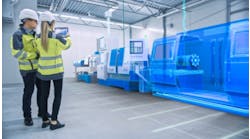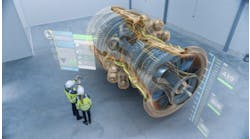How augmented reality is being used to transform the field-service workforce
By Samir Gulati, chief marketing and product officer at ServicePower
New technology is emerging to support more flexible and virtual lifestyles in the wake of the COVID-19 pandemic. Tools that enable a new way of working remotely are not only necessary, but hold potential to improve countless work processes. One such tool, augmented reality (AR), allows for interactive 3D experiences that combine a view of the real world with computer-generated elements. By 2028, the global market for AR is projected to grow 49%, reaching nearly $98 billion.
AR has many useful applications, especially as the Internet of Things (IoT) becomes prolific in the field-service industry. AR-enabled technology can help a remote workforce (think field-service technicians) connect with customers, suppliers and team members to solve problems faster and customize solutions.
Let’s explore three ways AR technology is helping repair and maintenance field teams work smarter:
1. Remote troubleshooting
Employees in the field who travel to homes and businesses to conduct repairs or make warranty assessments have historically relied on the customer to provide information needed to complete jobs. Artificial Intelligence (AI) and AR-powered support tools enable technicians and other workers to better prepare for service visits through real-time video conferencing that offers spatial orientation and virtual markers so that workers can identify the problem at hand and easily communicate with customers remotely. When technicians can tap into the customer’s point-of-view with interactive video and see what they are seeing, real-time responsive touchpoints make communication much easier for both the worker and the customer.
AI and AR capabilities increase customer satisfaction by facilitating the service process. AI tools can leverage optical character-recognition to read and store text details from customer photos to track product serial numbers in one digital platform. Meanwhile, technicians can advise with live sketches and provide repair directions in a shared AR view, allowing clients to address problems themselves or flag problem areas—live—to technicians.
The ability to remotely evaluate, troubleshoot and solve repair or assessment work requests can drastically reduce in-home, while resulting in improved job resolution and employee productivity by eliminating lengthy on-site visits. This also expands bandwidth to allow for more bookings.
2. Virtual collaboration
The country is currently facing a labor shortage across industries. This problem will persist in field services as demand grows and older employees retire, leaving knowledge gaps and understaffed teams to serve a growing market. AR and remote-support tools can mitigate these challenges by enabling less-experienced technicians to remotely collaborate with off-site experts. By duplicating the work view through AR, team members can collaborate from anywhere and provide advice to personnel servicing customers onsite and help improve first-time fix rates…the key to great customer satisfaction.
Furthermore, AR technology can help remote workers make better-informed decisions through computer-generated product information, including service manuals, diagrams, temperature and pressure readings, part numbers and descriptions. Ultimately, this additional data and information facilitates faster problem-solving for new and experienced technicians alike, decreasing task complexity and errors, improving worker confidence and job satisfaction, and increasing productivity so that more jobs can be completed overall.
3. Workforce management
Many organizations face hurdles and continuity issues when attempting to manage, train and dispatch remote workforces appropriately. By leveraging AR technology and virtual tools, team managers can provide comprehensive training, regardless of geographic or time barriers. Electronic pointers and 3D models can improve service efficiency and ensures real-time access to information necessary for job completion, enabling highly skilled technicians to focus on more complex jobs and assist junior agents with remote training via interactive video; this increases team efficiency and reduces costs.
In addition to helping train employees, AR- and IoT-enabled technology can help managers dispatch the best worker for each job based on skill set, location and workload for better workforce utilization, while tools such as location tracking and automatic call-logging allow for efficient team management.
Equipped with AR and digital support tools, remote personnel can finish jobs faster, complete more jobs in a single day, reduce the need for multiple visits, and enhance customer satisfaction—all of which makes field-service teams more profitable and enables organizations to build and maintain an optimally performing remote workforce quicker, cheaper and with less effort.


